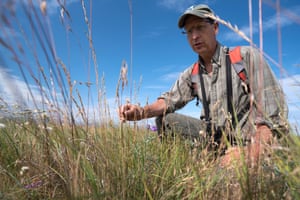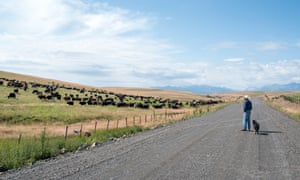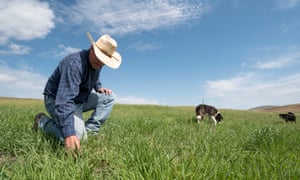Is the Way Cattle Are Grazed the Key to Saving America's Prairies?

“The article below gives another example of the application of holistic grazing concepts for the purpose of regenerating rangelands.
NOTE: this article was originally published to NYTimes.com on January 13, 2020. It was written by Karen Weintraub.
An unlikely alliance of ranchers and conservationists is working to find the best way to preserve biodiversity on grassland in Oregon
In the north-east corner of Oregon there is a traffic jam of weathered pickups and horse trailers on the Zumwalt Road. Redwing blackbirds trill over the bellowing of hundreds of cattle clustered by corrals, the sign of a spring branding in progress. Half a dozen cowgirls and cowboys on horseback circle the herd, lassoing calves for brands, vaccinations and, for the steers, castration. The smell of singed hair hangs in the warm air.
Standing in the centre of the scrum is Dan Probert, owner of Lightning Creek Ranch. Probert, 56, smiles as he watches the roping teams deftly manoeuvre his animals.
After branding, Probert’s Angus cross herd will be turned out on Lightning Creek’s pastures as part of an ambitious partnership with The Nature Conservancy (TNC) designed to protect the Zumwalt prairie, the largest surviving native bunchgrass prairie in North America.
The high, rolling Zumwalt, which stretches 500 square miles (1,295 sq km) between the glaciated Wallowa Mountains and the Wallowa-Whitman National Forest, is gouged by rivers that plunge into Hells Canyon, forming Oregon’s border with Idaho. This diverse ecosystem supports key populations of raptors, songbirds, bees, butterflies and rare native plants, along with elk herds and other wildlife.
TNC estimates that over the past 150 years as much as half of all US grasslands may have been lost, mainly to farming and real-estate development. With just 313m hectares (775m acres) of public and private rangeland left, much of it in the west, conserving this unprotected tract of the privately-owned Zumwalt is a priority for the conservancy.
In 2000, TNC established the Zumwalt Prairie Preserve with the goal of protecting the rich biodiversity within its 51-square-mile sanctuary. But TNC lands comprise just one-tenth of the Zumwalt prairie, which has been prized grazing land for generations of local ranching families. Over the past decade, the nonprofit has cultivated relationships with a dozen landowners who raise cattle in an effort to promote sustainable grazing practices throughout the entire Zumwalt.
Cattlemen and conservationists are not natural allies. Ranchers use the land to earn a living, often claiming to be conscientious stewards. But a long history of overgrazing has degraded the soil, fouled waterways and destroyed plant and wildlife habitat. In this remote corner of Oregon, tensions between conservationists and ranchers flare up over the presence of grey wolves, for instance, and a flowering plant called Spalding’s catchfly, which is on the US endangered species list.
Initially, the local ranching community was wary of TNC’s involvement with the Zumwalt; some worried the organisation had an “anti-grazing” agenda. Meanwhile, some of TNC’s donors and staff didn’t think cattle had any place on Oregon’s largest private nature preserve.
TNC is attempting to bridge this divide by using science to demonstrate that the goals of livestock producers and conservationists can coexist – and make the entire Zumwalt ecosystem healthier in the process.
The partnership with Probert and other ranchers is integral to discovering the right balance of practices and to answer questions such as how many cows on a pasture, at what time of year and for how long, so that both ranchers and the prairie prosper.
As the first rancher outside the preserve to sign up long term to the project, Probert is the linchpin. “If I can’t make a living, the whole thing falls apart,” he says.
Learning from history
Jeff Fields stands on a ridge overlooking the prairie on a bright June day. The carpet of spring-green grasses and wildflowers looks timeless and wild. But Fields, a biologist who manages the Zumwalt Prairie Preserve, is quick to correct that perception. “It’s been a grazed landscape for a very, very long time,” he says.

He points to clumps of bunchgrass interspersed with geraniums, cinquefoils, lichen, and patches of bare soil. These plant communities, he explains, are dependent on “ecological disturbance” to stimulate regrowth year after year.
Throughout history, herbivores – from early antelope to the Nez Perce horse and cattle herds – have browsed the prairie’s bunchgrass, providing that crucial disturbance. “The prairie evolved with herbivory,” Fields says.
Managed grazing is an attempt to replicate that historical relationship using commercial livestock. It has become a central piece of regenerative agriculture, an umbrella term for a range of farming and ranching practices that capture sunlight and carbon dioxide to stimulate plant growth, boost organic matter in soil, and foster greater biodiversity both above ground and below.
As cows graze, they aerate the soil with their hooves and trample plants and other organic matter – including their droppings – into the soil. This stimulates growth, enriches the soil, increases water flow, and creates habitat, with knock-on benefits up and down the ecological chain.
Some longtime ranchers here insist the Zumwalt prairie was healthy before TNC got involved. But there had never been a rigorous assessment of its condition.
From 2005–2009, TNC collaborated with Oregon State University and the University of Idaho to assess the impact of low-, medium-, and high-intensity grazing as measured against land that wasn’t grazed at all. By varying the stocking rate – the number of animals multiplied by the amount of time they spent on each 40-hectare pasture – researchers were able to analyse how different grazing strategies affected everything from soil compaction and vegetation to songbirds and pollinators.

The results were mixed. Songbird nesting did not change significantly across the test plots with low to moderate grazing, for instance, but Savannah sparrows and grasshopper sparrows avoided the most intensively grazed areas. And while a higher level of grazing decreased bumblebee populations, it may have provided better nesting conditions for digger bees.
Instead of blanket conclusions, the data provided fodder for years of collaborative studies and shaped TNC’s Zumwalt grazing research programme.
Without an economic motive, the nonprofit can afford to limit grazing to meet conservation goals. Livestock are restricted to about half of the 13,350-hectare property and excluded from more than 400 hectares, including sensitive areas around streams. The five ranching families who lease TNC pastures adhere to a strict schedule of short-duration grazing lasting anywhere from one to 20 days.
The limited grazing programme Fields oversees functions as something of a control group for the experiment with Probert. But he acknowledges that their data collection tools provide only snapshots of individual plots at a moment in time, making it difficult to generalise across a grassland as vast and diverse as the Zumwalt. “It’s all a big mush of diversity,” Fields says.
One possible solution is a satellite research project underway with the University of Idaho, called RangeSat. TNC fits some of the cattle with radio collars to collect data about ground cover and grazing patterns. Over time, it will improve the computer biomass model of the Zumwalt, providing a big-picture view for ecologists and ranchers to make better land management decisions. “This is a big deal,” says Fields.
Holistic approach
Probert grew up on a ranch in nearby Enterprise, but left home after high school and spent the next 30 years on ranches in California and Oregon. “The day I left I wanted to come back,” he says. He was living in south-east Oregon when he heard that Lightning Creek Ranch, a 5,000-hectare property in the Zumwalt, was for sale.
He coveted the property, but says he “couldn’t swing the price tag”. So he struck a deal with TNC in which the nonprofit helped Probert finance the ranch, and in exchange he promised not to plough, subdivide, mine or erect wind towers on the land in perpetuity. The contract, called a “conservation easement”, is becoming increasingly popular in the west as a way to protect open lands against the incursion of real estate developers.



Rancher Dan Probert believes intensive grazing followed by a long recovery is the way to maintain grasslands
Probert took over Lightning Creek Ranch in 2014, and then spent three years hammering out a grazing management plan with TNC. “The big things were easy to agree on,” Probert says, but the parties struggled with the set of conservation goals encompassing the health of creeks, pastures, plants and wildlife, with routine monitoring and annual evaluations conducted in cooperation with TNC. Now in its fifth year, this “living document” is up for review before the end of the year.
Since 1985, Probert has been a follower of “holistic management”. Popularised by the wildlife biologist Allan Savory, it is based on the controversial theory that intensive grazing followed by a long recovery, called “rest”, is the best way to maintain vigorous grasslands – effectively the opposite of what Fields is doing on TNC land. Savory’s critics contend that these methods are not supported by science and have been used as justification for putting more cattle on the land.
Probert, though, sees it as a useful framework for trial and error, a way to constantly check and adjust his decision-making. After years of managing other ranches, Lightning Creek is his first opportunity to put holistic management fully into practice.
Two weeks after branding, Probert visits his pastures that line the Zumwalt Road; they are tall and thick from spring rains. Movable fencing divides one large pasture into 80-hectare paddocks, and the cattle are moved between paddocks every few days.
Probert’s agreement with TNC doesn’t dictate how many cattle he puts into a pasture, or how long he leaves them there. “We think we are still pretty darn independent,” Probert says. Instead, the grazing plan is built on specific objectives for stream channels and riparian areas, soil and plant composition, native wildlife and plant habitat, and invasive weed management, as well as Probert’s cattle production.

TNC’s rangeland ecologist routinely evaluates Lightning Creek’s pastures using monitoring tools, or indicators. One measures how much of the standing plants the cattle have eaten, for instance, while another assesses the “grazing response index”, based on grazing intensity, seasonality, and allotted recovery time.
Probert’s pastures have consistently achieved good ratings over the past four years, according to Fields. But with so much complexity, it’s hard to generalise at this stage of the project. Fields notes, for example, that creek recovery on Lightning Creek Ranch is progressing slower than on TNC’s lands.
Probert drives his pickup into a pasture where 1,300 cattle have just grazed for three days. The grasses are trampled and unevenly munched, the wildflower blossoms stripped. It is a dramatic contrast to the lightly grazed, blooming pastures on the TNC preserve.
Probert is pleased. “Some people may say it looks bad,” he says. “It isn’t bad.” In the ideal world of holistic management, every plant gets grazed once. TNC’s more conservative approach means that many plants don’t have that bite taken out of them so that they retain biomass and generate better root systems. Probert considers this management practice, called “over-resting”, detrimental.
He points to the green stubble of a munched plant. “This one is doing its job, turning carbon dioxide and water into new green leaves that support wildlife or livestock.”
Every spring Probert defers grazing on some pastures to protect nesting songbirds, and he manages his cattle to prevent browsing on trees that provide habitats for raptors and elk calves. The recently grazed pasture will be rested for a full year, minimum, until the grasses are waist-high again. “We’re seeing rapid changes in terms of soil health, water infiltration and health of plants,” Probert says.
So far, it is working for him financially, too. Each year he has been able to raise more animals on the same amount of ground. Four years ago, he was running 900 cattle on pastures where he now runs 1,100.
“At the end of the day, we’re turning more sunlight into more growing plants, and then we’re putting those plants through an animal that we hope makes us a saleable product,” he says.
Long haul
Fields does not subscribe to Savory’s intensive grazing model, or even agree with Probert’s contention that livestock grazing is essential to maintaining the health of the Zumwalt. “I don’t think we need livestock grazing to make a healthy grassland,” he says, mentioning the abundant deer, elk and ground squirrels that also graze the prairie.
For their part, local landholders don’t think the longevity of these grasslands depends on TNC’s efforts either. “People have always thought the Zumwalt was worth preserving,” is how one rancher put it.

But both groups have invested in a partnership staked on continuous improvement for the long haul. And despite the fact that they don’t always speak the same language, Probert says “TNC is a good neighbour”, which is a high compliment in these parts.
Fields says of Probert: “The most valuable asset we have is an educated, curious and consistent observer who is willing to change his behaviour based on what he observes.” When the two meet in the autumn to review Probert’s grazing management plan, neither anticipates big changes.
As the project evolves, the goal is to continue gathering evidence for a variety of practices to support sustainable grazing – Probert’s, TNC’s, something in between – that make sense on the Zumwalt.
“From a scientific lens we’d be foolish to think we can reduce it to a simple, ‘Do this, don’t do that’,” says Fields, but “if we have different grazing systems and monitor consistently, we’re going to get a richer answer.”
• This article was produced in collaboration with the Food & Environment Reporting Network, a nonprofit news organisation
Find more age of extinction coverage here, and follow biodiversity reporters Phoebe Weston and Patrick Greenfield on Twitter for all the latest news and features
